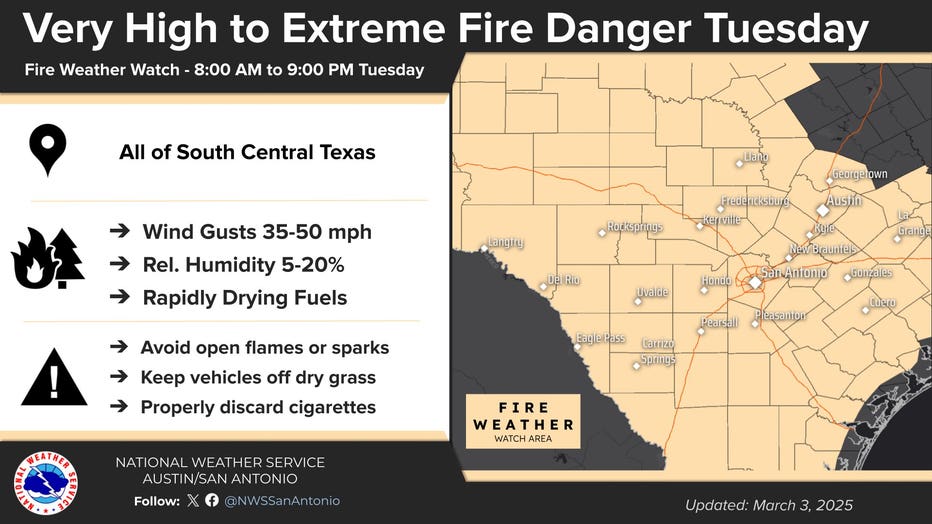Austin weather: Fire Weather Watch upgraded to Red Flag Warning for Tuesday, March 4
AUSTIN, Texas - A Fire Weather Watch set for Tuesday has been upgraded to a Red Flag Warning due to ‘critical to extreme fire danger’, says the National Weather Service.
The watch will be in effect from 8 a.m. to 9 p.m. CST March 4.
The NWS says that Red Flag Warnings are issued when fire conditions are ongoing or expected to occur shortly.

Due to fire danger, Gov. Greg Abbott has activated additional emergency response resources. He said Texans are urged to follow state and local officials' guidance and to limit activities that may cause sparks.
Red Flag Warning
Timeline:
The NWS says that a strong storm system and Pacific cold front will be moving across south Central Texas on Tuesday morning (March 4).
Strong winds and very dry air will spread across the region behind the front and continue through the evening. However, winds will decrease and humidity will recover after sunset, gradually reducing the fire threat, says the NWS.
Due to this strong system, Travis and Williamson Counties have declared a local state of disaster that prohibits outdoor burning. The order will be lifted by the county judge whenever conditions improve.
Dig deeper:
The NWS says sustained winds are expected to be between 25 and 35 mph along the I-35 corridor and west to the Rio Grande by Tuesday afternoon. Gusts of 40 to 50 mph, potentially exceeding 50 mph. are forecast to move across Val Verde and Edwards counties.
Temperatures are forecasted to be in the upper 70s and up to 85. Relative humidity values are forecast at around five to 15% along the Rio Grande east to the I-35 corridor, and around 15 to 20% across the Coastal Plains.
The NWS is also warning that any wildfires that start could rapidly increase in size and intensity, and move quickly, making suppression efforts difficult.
The Texas A&M Forest Service says that dormant fire season herbaceous fuel loading is above normal throughout much of the Hill Country.
Which counties will be under the Warning?
What we know:
The following Central Texas counties are included in the Watch: Atascosa, Bandera, Bastrop, Blanco, Bexar, Burnet, Caldwell, Comal, De Witt, Dimmit, Edwards, Frio, Gillespie, Gonzales, Guadalupe, Hays, Karnes, Kendall, Kerr, Kinney, Llano, Maverick, Medina, Real, Travis, Uvalde, Val Verde, Williamson, Wilson, and Zavala.
Burn bans in effect
Local perspective:
Several counties included in the Watch have burn bans currently in effect, according to the Texas A&M Forest Service map:
- Atascosa County
- Bandera County
- Bexar County
- Blanco County
- Dimmit County
- Edwards County
- Frio County
- Karnes County
- Kerr County
- Llano County
- Medina County
- Real County
- Uvalde County
- Val Verde County
- Wilson County
Wind Advisory
In addition to the Warning, a Wind Advisory is set to go into effect Tuesday morning.
What we know:
The Advisory will be in place from 9 a.m. to 6 p.m. March 4.
West winds are forecast to be 25 to 35 mph with gusts of 45 to 55 mph expected.
The NWS is warning Central Texans that gusty winds will blow around unsecured objects and may blow down tree limbs, which could result in power outages. These strong winds can also make driving difficult, so drivers are advised to use extra caution on the roads.
What you can do:
A Red Flag Warning means that critical fire weather conditions are either occurring now or will shortly.
The NWS is advising Central Texans to:
- Avoid any open flames or sparks
- Keep vehicles off dry grass
- Properly discard cigarettes
The Texas A&M Forest Service says that people and their activities cause more than 90 percent of all Texas wildfires, with the largest number caused by careless debris burning. Other causes of wildfires include sparks from welding and grinding equipment, carelessly discarded smoking materials, vehicles’ exhaust systems and arson.
The Forest Service has more advice and tips to prevent and protect yourself and your home from wildfire danger here.
The Source: Information in this report comes from the National Weather Service and the Texas A&M Forest Service.

